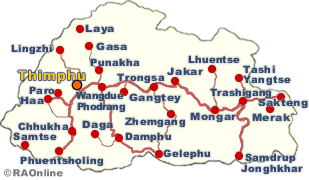|
Bhutan
- Ethnic Groups & People |
 |
Bhutan's People |
|
 |
Bhutan Information |
|
|
 |
|
Traditional medicine
|

|
Dungtshos
(traditional physicians) in Bhutan are far more fortunate than other traditional
medicine practitioners in the region say two senior Bhutanese traditional
physicians who recently attended an international conference of dungtshos
in Kathmandu."The practice of sowa rigpa (traditional medicine) in Bhutan has a strong political support that traditional medicine practices
elsewhere do not," said the director of the institute of traditional medicine
services, Dorji Wangchuk, who accompanied the Bhutanese dungtshos.
 |
Yartsa Goenbub
The
conference of amchis (dungtshos) held in Kathmandu from January 25-29,
2004, was the first international conference of its kind where more than
35 dungtshos from the Himalayan region of Mongolia, Tibet, Ladakh, Nepal
and Bhutan took part. While sharing of information and experiences
was the highlight, the foray was largely designed to seek the support and
recognition from governments to the ancient and unique medicinal practices. |
Except for Mongolia, no other region had the support from the government
to the traditional medicine practice. Comparatively,
traditional medicine practices in Bhutan given the moral and money support
from the government and donor agencies like the European Union, was not
only gaining momentum but flourishing in its education, practice and content.
Its services were also given free of cost to people.
 |
According
to the superintendent of the institute of traditional medicine,
dungtsho Tshering Tashi, the institute was established in 1967 as
an indigenous unit on the command of the Third King of Bhutan to keep alive
the custom of traditional medicine doctors and to promote the unique system
of medical care that was based on the country's culture and tradition.
From a tiny unit in Dechencholing, the institute today boasts a
traditional medicine hospital, a national institute of traditional medicine
which offers a bachelors degree programme, and a pharmaceutical and research
unit in Thimphu. |
It
also has indigenous units in all the 20 dzongkhags manned by a dungtsho
and a menpa (compounder) serving as complementary to the modern medical
services and are housed in the same building as the district hospitals.
The institute till date has produced 37 graduates and 38 diploma students,
most of them employed in the institute. The number of patients treated
by the institute's hospital in Thimphu has also increased from a few hundred
in the past to more than 40,000 annually. Combined, the indigenous units
in all the dzongkhags treat about 100,000 patients in a year.
People
come to the indigenous hospitals for different ailments from athritis,
stomach ulcers, rheumatism and various pains and aches to emerging diseases
such as hypertension. Services most sought after are herbal bath, herbal
steaming and herbal massage. The institute also manufactures 103 compounds
that constitute the essential list of traditional medicines like pills,
tablets, syrups and ointments. The raw materials are all herbal plants
found in plenty in the country. The Tsheringma herbal tea which is known
to help digestion is one of the institute's products sold in the domestic
market.
According
to Dorji Wangchuk, traditional medicine practice is linked with the country's
Buddhist philosophy. Shabdrung's minister of religion, Tenzing Drukey,
a highly respected physician started the teaching and spread of traditional
medicine in Bhutan from 1616. Since then the Bhutanese traditional
medicine has developed independently of its Tibetan origin. Being the land
of medicinal plants, Bhutan's rich herbs available in abundance helped
spur the practice and the development. The principle and practice was then
passed on orally to the younger generation till the system was formalised
in 1967 as an integral part of the national health care programme.

|
| This
article was contributed by Kuensel, Bhutan's National Newspaper |
| Information on Bhutan |
 |
|




